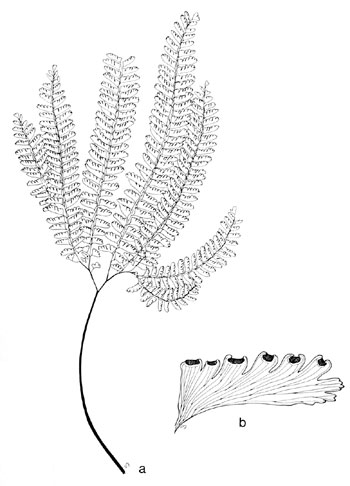|
Hardy Fern Home A. aleuticum resources
All Ferns � Pteridaceae �� Adiantum
�Other Genera
|
| Adiantum aleuticum | ||
Western maindenhair | ||
|
Etymology
Aleuticum references the Aleutian Islands, off the coast of Alaska.
Description
Rhizome: short-creeping, scales bronzy deep yellow, concolored, margins entire.
Frond: 40 cm high , deciduous, monomorphic, blade/stipe ratio: 1:1 more or less. Stipe: purplish-black, grooved above, to 2 mm diameter, glabrous, occasionally glaucous or a few scales at the base, vascular bundles: 1 or 2. Blade: pedate, the primary divisions then pinnately divided, fan-shaped or almost circular, membranaceous, glabrous. Pinnae: 6 to 10 pair, oblong, those closest to the stipe longer, diminishing steadily outwards, slightly tapering to the base, abruptly tapering to the apex; strictly speaking, not really paired; pinnules oblong, deeply incised; margins crenate; veins free, forking from the main vein along the lower margin. Sori: oblong, submarginal on the upper margin of the pinnule, indusium: false, inrolled margins, sporangia: yellow or yellowish brown, maturity: summer to fall. Dimensionality: Vertical or ascending pinnae.. Culture
Habitat: wooded ravines, shaded banks, talus slopes, serpentine barrens.
Distribution: western North America, disjunct in many locations in the Rockies, in eastern North America, and in Mexico.
Hardy to -35�C, USDA Zone 3.
Distinctive Characteristics
Adiantum pedatum and Adiantum aleuticum are very, very similar, the nomenclatural history for the latter providing testimony. The division into two specific taxa is recent, the keys in the Flora of North America often enough leading to unexpected results. One difference, not in the key,�stands out: A. aleuticum sometimes has ascending or vertical pinnae, A. pedatum�always has horizontal. This is, of course, unsatisfactory.
Synonyms
Adiantum pedatum Linnaeus var. aleuticum Ruprecht Adiantum boreale C. Presl Adiantum pedatum subsp. aleuticum (Ruprecht) Calder & Roy L. Taylor Adiantum pedatum subsp. calderi Cody Adiantum pedatum subsp. subpumilum (W. H. Wagner) Lellinger Adiantum pedatum var. subpumilum W. H. Wagner |
|
|
